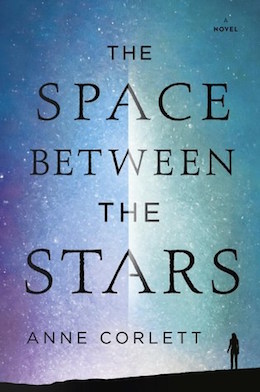The Space Between the Stars is Anne Corlett’s first novel. It is a striking effort that explores life, death, love, isolation, and the search for meaning in an uncaring universe, and one that treats these topics with a surprisingly accomplished touch. I read it back to back with another debut novel, Katie Khan’s Hold Back the Stars, with which it shares several apparent similarities (notably, a miscarriage provides part of the emotional background of the main female character in both novels). The contrast shows to some effect: Corlett is far more successful at giving her themes weight and resonance.
Reading The Space Between the Stars, I was struck by how much it was in dialogue with the same themes as Joanna Russ’s We Who Are About To… The two books are very different in their structures, in their characters, and in their emotional arcs—We Who Are About To… tends towards bleak defiance, while The Space Between the Stars moves from despair to a place of hope—but they are both concerned with death and civilisation.
For those who are not familiar with Russ’s work, We Who Are About To… is the story of a small number of people—less than a dozen—who crash-land on a planet that is at least temporarily survivable. They have no hope of rescue and no way to get back to the rest of human civilisation. The narrator is a woman who understands that they are doomed, and is determined to live what remains of her life with autonomy and self-respect. Most of the rest of the party, however, especially the men, are determined to found a new civilisation, a project which will include rape and forced pregnancy for the women. (A probably futile endeavour, given the numbers, leaving aside the utter immorality of such a case.) We Who Are About To… is a furious, polemical novel about autonomy, personhood, and the choices we make as humans when facing death and the prospect of being forgotten to memory.
The Space Between the Stars is neither furious nor polemical. But it explores human connection and human ways of dealing with isolation and the prospect of extinction, after a virus has swept through human space, leaving only thousands (or perhaps tens of thousands) alive where once there were billions.
Jamie Allenby, the viewpoint character, was a vet on the frontier planet of Soltaire before the virus. She wakes, having survived, to an empty world. An undecipherable communication leads her to the conclusion that her estranged partner Daniel has also survived, and that he intends for them to meet on Earth. Here, at the end of everything, she decides that she loves him still. As she strives to reach Earth and her childhood home on the Northumberland coast, she encounters other survivors, some of whom form a small community for traveling to Earth: a former priest, an extremely religious scientist who is disturbed in her mind and believes that God has chosen them all to make a new world, a taciturn spaceship captain and his unsociable engineer, a young woman who was a professional prostitute, and a young autistic man.
As they travel, they encounter other small communities of survivors, and must face the different ways in which people are reacting to the new status quo. Some of them are responding violently, and trying to replicate the social divisions of the old world—trying to enforce their hold on power and reproduce the world they knew. And when Jamie finds her former partner, she must face the knowledge that her view of him does not coincide with the person he is now.
On Earth, they find other people who have survived the end of the world: a young woman in a bookshop in Alnwick, trying to keep the remains of the internet alive with the aid of people of the far side of the world; a community of aged Regency re-enactors, determinedly ignoring the near-extinction of the species. At last, at Jamie’s childhood home, she encounters someone whom she never expected to see again—her stepmother, with whom she had a strained relationship in her teens.
The Space Between the Stars intersperses the present-day narrative with small snippets from Jamie’s past, giving us a larger picture of the kind of woman she is and the relationships that formed her. This fills out the world, and makes Jamie’s isolation more poignant. We come to understand that she was always, perhaps, isolated, and that now, in the isolation of post-plague humanity, she might finally reach beyond her own personal isolation. And here, near the island of Lindisfarne with its two surviving monks, she must come to terms with learning that the plague was not, after all, a natural disaster.
In its emotional arc, in its concern with connections and its respect for individual choices and autonomy, The Space Between the Stars recalls Becky Chambers’ The Long Way to a Small Angry Planet (though it is not nearly as concerned with queer themes as Chambers’ work). It has something of the same sense of a small, enclosed, misfit community.
The Space Between the Stars is, ultimately, a kind novel. Strikingly written, with very human characters and a deep concern with human frailty, it is an excellent debut. I recommend it, and I look forward to seeing what Corlett does next.
The Space Between the Stars is available now in the UK and publishes June 13th in the US from Berkley Books.
Liz Bourke is a cranky queer person who reads books. She holds a Ph.D in Classics from Trinity College, Dublin. Find her at her blog, where she’s been known to talk about even more books thanks to her Patreon supporters. Or find her at her Twitter. She supports the work of the Irish Refugee Council and the Abortion Rights Campaign.










